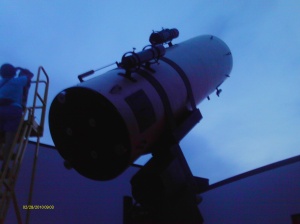
(Chris Mentrek, naturalist at the Geauga Parks New Observatory Park.)
The Geauga Parks New Observatory Park is an 1,100-acre park that’s tucked away in one of the darkest corners of Northeast Ohio.
The new park boasts an observatory with a 25-inch telescope and a planetarium for those nights when clouds obscure the telescope’s vision.
Admission to the park and its activities is free. They are also seeking other uses for the parkland. The park offers some other unusual ways to explore the solar system on foot. They are encouraging hiking on the trails and pointing out that the park includes the Cuyahoga River headwaters and some spectacular rock formations similar to Nelson Ledges. There is a 1.8 mile trail that takes you through the planets that encircle our earth. The distance from earth to the planets is roughly scaled from millions of miles to a few feet. You can walk the trail to Neptune or Mercury in a matter of minutes instead of light years.
While we were at the park, we witnessed hobbyists firing model rockets that shot hundreds of feet into the sky. The slim rockets returned to earth under small parachutes. “It’s just one more way that people can use and enjoy all the open land that we have in this park,” said Mentrek.
Chris Mentrek is a naturalist at Observatory Park, the brand-new Geauga Park District’s facility in Montville Township. Observatory Park is located at 10610 Clay Street in Montville. Call (440) 286-9516 or visit www.Geaugaparkdistrict.org.
Mentrek said that on a clear night, you can see the majesty and width of the Milky Way out here. That’s something that you cannot see near downtown Cleveland or in most people’s backyard.”
“Eventually, within a couple of years, we will have two telescopes. The old Case Western Reserve Observatory is on our grounds and it is being rebuilt. When completed, it will have a telescope with three times more power than our present telescope.”

The first thing you see as you leave the parking lot is a 12-foot high sundial that, on sunny days, allows you to see the time.
(my girls playing on the sundial as we attended the park’s grand opening…which has some great kids activities, live music and free food)
At the Observatory, there is a weather station where you can see the speed of wind, the amount of rain and the barometric pressure. Next to that is a working seismograph that measures earthquake activity around the world. In fact, the day I was there, it registered a small earthquake that had just occurred in Alaska.
Unlike many county and Metroparks, Observatory Park is open into the late hours of the day. Hours year-round are 6 a.m. to 11 p.m.
“If we are having a program in the late hours, it can even go past midnight,” Mentrek said. “We try to stay open as long as necessary on nights that there are really cool things happening in the sky.”
So while Geauga Observatory Park is about a ~one tank trip~away, it is well worth the trek. Pack the picnic basket and take the family or your sweetie on an adventure. You can picnic on open land or dine inside where it’s cozy and warm.
Whatever you prefer!
Happy Frrrreeeee Hunting!



